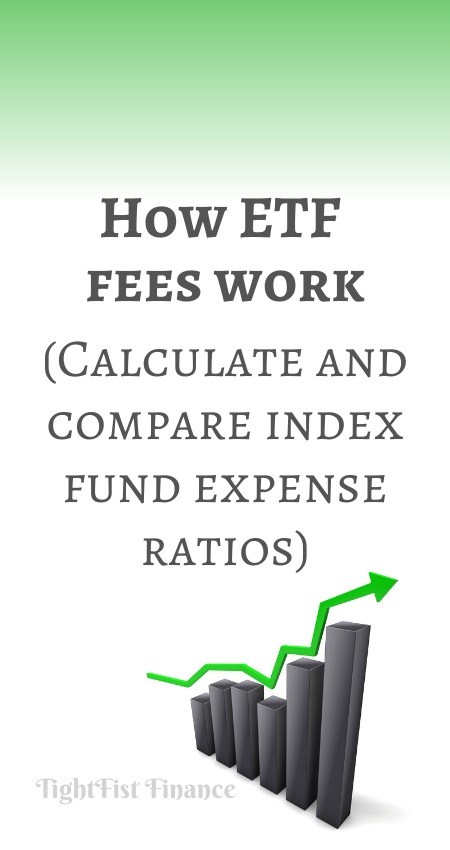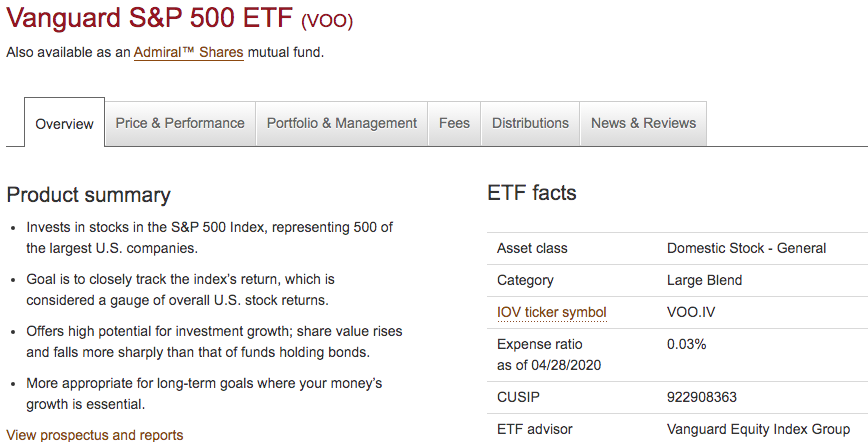How do ETF fees work?
ETF fees or “expense ratios” are charged by the fund manager which is how the brokerage makes their money. Typical fees range from 0.03% all the way up to 1% or more. The fee is the amount of money that will be deducted from your portfolio over the course of one year.
Imagine, investing with confidence knowing that you aren’t losing money to insanely high fees. How would you like to retire with a lot more money?
It’s important for you to understand how ETF fees work in order to protect your investments.
Luckily for you, I’m going to show you how ETF fees work. I’ll show you how to avoid costly exchange traded funds, so you can have more money. Best of all, I’ll show you where you can find low cost ETFs to invest your money in.

This article may contain affiliate links which pays a commission and supports this blog. Thank you for your support!
How do ETF fees work?
An ETF fee is the amount of money charged by a fund manager for providing their service. ETF fees are determined by the fund manager and can change over time. The fee is expressed as a percentage which is charged annually.
Expense ratio is a fund management fee
You can determine what the ETF fee is by visiting the fund’s overview page. For example, VOO is the Vanguard S&P 500 Index Fund. When visiting their overview page, I can find all the information about the fund including the expense ratio.

As you can see, Vanguard’s VOO has an expense ratio 0.03%.
Each fund includes a prospectus. A prospectus is essentially a summary of the fund or information packet.

Looking through the VOO prospectus, I can see that 0.02% of the expense ratio goes to management fees. 0.01% of the expense ratio goes to other expenses.
Turnover fees are for buying and selling securities
You should also note that an exchange traded fund may have other fees such as a turnover fee. A turnover fee is the cost associated with buying and selling a security, which the fund manager does for you. Turnover fees are separate from expense ratios and may create tax implications.
For example, VOO reported a turnover rate of four percent in their prospectus. So four percent of the stocks in VOO were replaced with something else. There will be a turnover fee associated with buying and selling those securities.
Look for funds that have a low turnover rate. Lower turnover rates mean there is less buying or selling, which can have tax implications.
How are ETF fees calculated?
Expense ratios are an annual fee which is assessed on your portfolio balance. Multiply the expense ratio as a decimal by your portfolio balance to determine the fee. For example, a $50,000 portfolio with an expense ratio of 1% would have a yearly fee of $500.
How to calculate the total cost of an ETF
Use an expense ratio calculator to determine the overall impact of fees on your portfolio. You can use the expense ratio calculator to compare the overall cost of expense ratios of different ETFs.
Are ETF fees worth it?
Low-cost ETF fees are certainly worth the benefit they provide. However, you should avoid finding costly ETFs. Even a small difference in expense ratio can result in paying or saving a lot of money over time.
Let’s look at two different S&P 500 exchange traded funds. The first ETF we will look at is VOO, the Vanguard S&P 500 ETF (expense ratio of 0.03%). Invesco also has an S&P 500 fund, but with a 1.29% expense ratio!
Most new investors don’t even pay attention to expense ratios. Unfortunately, not paying attention to ETF fees can be a very costly mistake.
Let’s assume you’ve got $10,000 invested and will keep investing $5,000 per year over 30 years. Assume you’re going to get an 8% return on investment.

Choosing Investco over Vanguard will cost you an extra $144,566.38 in fees! Should you have invested with Vanguard, you would have only paid $4,000 in fees.
Both of these funds are an S&P 500 fund. You are paying for tracking the exact same index. Why would you want to pay nearly an extra $150,000?
What is a good expense ratio for an ETF?
Good expense ratios for exchange-traded funds are typically below 0.2%. However, every investor should try and get low cost exchange traded funds to avoid excessive fees. Most ETFs can’t outperform the market, so there’s no reason to overpay what you can already buy for a low price.
What are the best things you can do as an investor is shop around. You may want to invest in S&P 500 Index Fund. Plenty of brokerages offer an S&P Index Fund, so what are their fees?
Where can I find low cost ETF fees?
Vanguard offers some of the lowest cost ETFs compared to any other brokerage. Most Vanguard ETFs have an expense ratio between 0.03% and 0.15%. You do not need a Vanguard account to buy a Vanguard ETF.
My personal preference is to invest with Vanguard. Most brokerages don’t come anywhere close on the cost basis for what Vanguard can provide. Therefore, you should always start shopping around by seeing what Vanguard has to offer.
One of the common mistakes is thinking that you need to open a Vanguard account to purchase a Vanguard ETF. Fortunately, you can buy any Vanguard ETF from any brokerage account.
Click to Tweet! Please Share!Click To TweetSummary: How do ETF fees work
As you can see, ETF fees are typically referred to as an expense ratio. Expense ratios is an annual fee that is charged for managing the fund. Therefore, investing $100,000 with a 1% expense ratio would cost you $1,000 in fees.
It is important to consider ETFs with a low expense ratio. Many brokerages offer the exact same fund, but charge different rates for providing the fund. Therefore, you can pay a lot more money for the exact same product.
Typically, I Look to invest in expense ratios below 0.2%. However, most of my expense ratios are anywhere between 0.03-0.15%. I find low-cost exchange-traded funds by investing with Vanguard who offers some of the best prices around.
